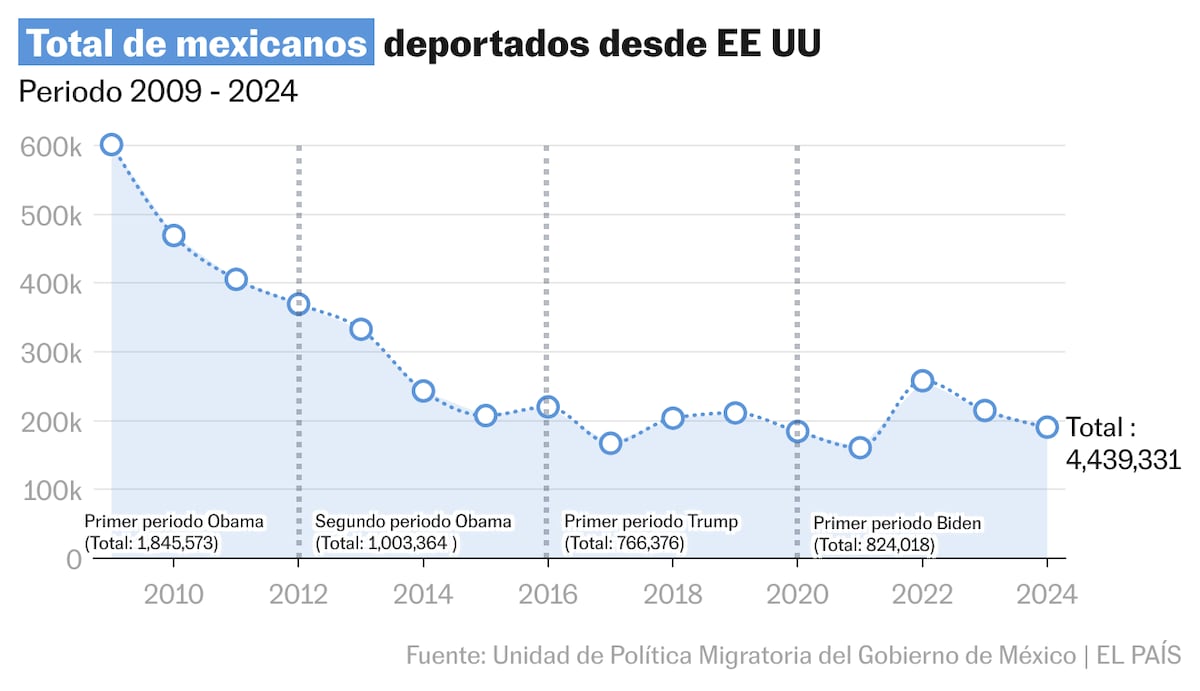The objective of Donald Trump, president of the United States, to undertake massive deportations of migrants looks at hundreds of thousands of Mexicans in an irregular situation. The risk of being returned to your country of origin, however, is not new and is probably not greater this time than in other years. A look at the Mexican government figures on deportations of nationals shows that US institutional machinery against papers without papers works tirelessly. In three decades, from 2009 to 2024, the United States government has deported to 4,439,331 Mexicans in irregular immigration situation. Against what could be thought, Trump’s first administration was not the toughest, although it is about to be seen if that situation changes now that the Republican has returned to the White House with a more charged speech to the Xenophobic and racist extreme right.
The deportation figures reviewed by the country cover the two periods of government of Democrat Barack Obama (2009-2013 and 2013-2017), the first mandate of Republican Trump (2017-2021) and the only management of Democrat Joe Biden (2021- 2025). The Obama administration has the reputation of being the most migrants of all nationalities threw out of the United States. That condition is also expressed in Mexican deportations. In his first government, Obama repatriated 1.8 million undocumented migrants; In their second period, just over one million Mexicans ran with the same fate. Trump, in his first four -year period, deported 766,373 Mexicans. His successor, Biden, has returned to 824,018 (in the latter case, the figures of December 2024 and January of this year are not yet available).
In a single month, March 2009, Obama deported almost 70,000 Mexicans, a sample button of its aggressive anti -immigrant policy. Other months in the same year were almost equally drastic: 63,000 deported in April, 57,000 in May, 54,000 in June. On the other side of the currency, April 2020, in the Trump era, it is the month in which less Mexicans were repatriated: 9.113. May of that year is the second with less repatrices of nationals in all three years: 9,654. The average deportations per month in the revised period is 23,300.
According to data from Think Tank Latino Donor Collaborative, in the United States there are 37 million Americans of Mexican origin, a figure that includes migrants and their descendants born in that country. The organization argues that, in general, the Latin community provides 3.6 billion dollars to the US gross domestic product (GDP), with data from 2022. Of that total, 2,06 billion dollars correspond to the wealth generated only by the workforce of Mexican migrants.
Deportation data are collected in Mexico by the Ministry of the Interior, in charge of immigration policy. The joint numbers allow observing some demographic features of repatriated Mexicans. For example: 9 out of 10 deported Mexicans in the United States in the last three years are men, and the rest, women (3.9 million against 512.852), a sign that those who migrate the most north from Mexico are men.
Of the total repatriated Mexicans, almost 282,000 were under 18 (6.3%). The vast majority were deported with some adult, although there were also some hundred cases in which minors were not accompanied. The year in which more migrants were deported has been 2024, the last of the management of Biden, with a record of 28,270. The second largest case was 2009, with just over 26,000. In 2017 there was the least figure of returns from minors, with just under 9,000 cases. However, the enormous mass of repatriated was over 18 and was of working age (more than 93%), so it can be presumed that they were migrants with some occupation at the time of their return.
The information of the Ministry of the Interior also allows to know what was the state of origin of the deported Mexicans as of 2010 (before that year the information was not disaggregated by the place of departure). Only eight states agglomerate 48% of migration to the United States in the three lustrous: Michoacán, Guerrero, Oaxaca, Guanajuato, Puebla, Chiapas, Veracruz and State of Mexico. Put in other words: in the last 15 years, at least 2.1 million Mexicans started from those places (the figure is necessarily higher, considering Mexicans who continue in the US). These eight states have something in common: they are located in the center and southern Mexico, historically less developed regions, in the sense that governments did not prioritize their industrialization in decades.
Conversely, the list of the states that least migrants have expelled the head of Baja California Sur, despite its proximity to the US border. Campeche, Yucatán and Quintana Roo, located in the Mexican Peninsula, the most section of the border, are also part of that group. Another remarkable case among these states is that of Tabasco, despite its location in the southern south of Mexico, next to Chiapas, Veracruz and Oaxaca.
The figures compiled by the Mexican government help to understand the dynamics of migration to the US. The departure of tens of thousands of people from the center and the south of the country indicates the inequality gap pending to close. For this reason, the massive return of migrants to their places of origin will mean enormous pressure for states with weak economies. The president of Mexico, Claudia Sheinbaum, as at the time her predecessor, Andrés Manuel López Obrador, has indicated that a priority of her administration is to detonate the development of the abandoned south so that the inhabitants find life opportunities there and they do not see forced to migrate. For now, the president has announced a series of relief for Mexicans that Trump sport in this new era, from jobs to government transfers.








